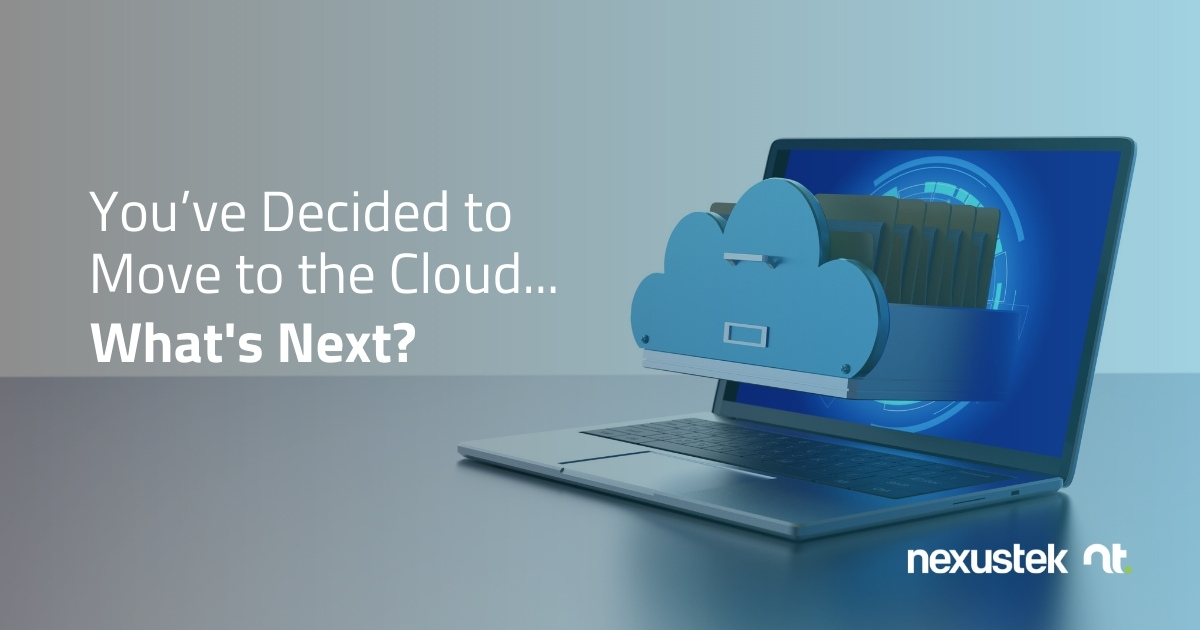READ TIME: 4 MIN

You’ve Decided to Move to the Cloud…What’s Next?
If your business has decided to make the switch to a cloud-based infrastructure, your “why” is probably pretty straightforward. With benefits like quick scalability, high reliability, reduced total cost of IT ownership, and flexibility to work from anywhere, cloud-based infrastructure is becoming the model of choice for enterprises and smaller businesses alike.
But when it comes to the “how” of switching to the cloud, that gets a bit more complicated. Although many small and medium-sized businesses (SMBs) choose to outsource their cloud migration to experienced technology professionals, it is still important for decision-makers to understand the migration process at a high level before making the plunge.
If you’re weighing the decision to go cloud-first but are hazy on the migration process, this article is for you. In the following sections, we review the major steps of moving to the cloud.
Discovery: Compile a full accounting of your IT resources.
The first step is fairly intuitive. If you are going to move your workloads to the cloud, you need to start with a complete list of all software and data your business uses, with notes on where each is stored. This means taking a full account of your on-premises servers and applications as well as any workloads currently running in the cloud.
Be aware that “shadow IT” is an increasingly common phenomenon, meaning that there may be employees or departments that are using applications that were never officially approved by your IT team or decision-makers. Any shadow IT should be included in your accounting. This is also a great time to start thinking about which applications are business-critical—and need to be accessed anywhere—and which applications you’d prefer to keep on-premises.
Connectivity: Make sure you have sufficient bandwidth.
This is an often-overlooked consideration but an important one. When you move to the cloud, your employees will be accessing their various business applications over the internet, rather than via your on-premises network. This means that the volume of data flowing through your internet connection will suddenly spike. Make sure you have an internet connection that can handle that volume to avoid slowing your operations to a crawl.
Cloud Models: Weigh your options.
When we talk about “the cloud,” it can sound monolithic, as though it’s one huge, pooled resource. But the truth is that the cloud is not a single environment. There are a variety of cloud providers, cloud models, and service types, and choosing the right arrangement for your business can be complex.
First of all, consider the difference between public and private cloud. Public cloud refers to multi-tenant environments where different users share space on the same servers. Private cloud refers to single-tenant environments, in which servers are dedicated to individual accounts or users.
You should also consider whether your business wishes to move entirely to the cloud or keep some applications and data onsite (i.e., a hybrid cloud model). Furthermore, think about whether your in-house IT staff have the time and experience to remotely manage your new cloud environment, or whether it makes more sense to task the cloud provider with managing your cloud infrastructure.
Risk Analysis: Identify possible issues that may impact migration success.
It is important to understand, at least conceptually, that relationships or “dependencies” exist between your applications. In essence, certain applications depend on other applications to function properly. These relationships are important to map out before attempting to migrate to the cloud because specific relationships may not be present or possible in the new cloud environment. If this issue is not identified before the attempted migration, then you will find that the affected applications won’t function properly or at all.
Compatibility issues can have a similar effect. As pointed out above, the cloud is not a single environment. Some cloud environments may use different operating systems and APIs than your business uses on-premises. Trying to run your workloads in such a mismatched environment would result in significant performance issues or even application failure.
Compliance: Make sure the new cloud environment measures up.
If your business is subject to data privacy and security regulations, you might be concerned about whether the cloud meets your compliance standards. The positive news is that cloud environments—when managed effectively—can meet the rigorous requirements of compliance standards like HIPAA, GDPR, and FINRA. When selecting a cloud provider, make sure they understand your regulations and are willing to complete agreements or other documents to support your compliance.
Security: Update your security strategy and policy.
When you switch to a cloud-first approach, your security strategy needs to change too. Your data will no longer be contained within the perimeter of your onsite infrastructure; it will now be located in a remote data center and accessed over the internet from endpoints like laptops, mobile phones, or tablets.
This diffuse network requires a different type of cybersecurity strategy since you now have to “guard the door” of every endpoint and user that connects to your network. A security program that adheres to principles of zero trust is highly recommended for a cloud-based environment, as it makes it harder for bad actors to get into your systems and limits the damage they can do if they do penetrate your network.
NexusTek offers cloud readiness assessments to support you through each step of your migration to the cloud. We also offer IT spend assessment to help you control your cloud costs. Whether you need a second set of eyes or full support with your cloud migration project, our expert engineers are here to help.
Are you ready to take the next step in your cloud migration journey?